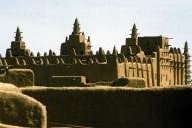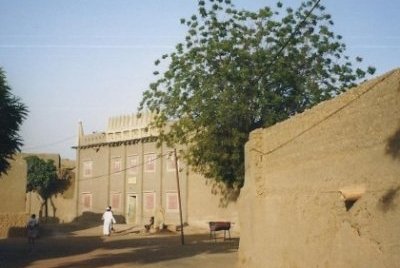Mali
Djenné
The Old Towns of Djenné comprise the city of Djenné with its typical architecture and the archeological sites of four pre-Islamic towns.
Djenné, situated on an island in the Bani River, was a prospering city from the 14th til the 16th century as an important station on the Trans-Saharan route. Its Grand Mosque, originally dating from the 13th century, fell into decay but was rebuilt in the early 20th century. It is replastered yearly in a festival-like event in the Spring. The associated archeological sites are Djenné-Djeno, Hambarketolo, Tonomba and Kaniana. They hold remains of traditional brick structures and have produced a wealth of terra cotta artifacts and metal.
Community Perspective: the Old Town is appreciated for its photogenic mud-covered mosque and old two-story houses. Solivagant also visited the archeological site of Djenné-Djeno.
Site Info
Official Information
- Full Name
- Old Towns of Djenné (ID: 116)
- Country
- Mali
- Status
-
Inscribed 1988
Site history
History of Djenné
- 2016: In Danger
- Due to insecurity in the area
- 1988: Inscribed
- Inscribed
- 1981: Deferred
- At Bureau - need info on protection
- 1980: Deferred
- In Danger
- Due to insecurity in the area Since 2016
- Type
- Cultural
- Criteria
- iii
- iv
Links
- UNESCO
- whc.unesco.org
All Links
UNESCO.org
- whc.unesco.org — whc.unesco.org/
News Article
- May 28, 2022 voanews.com — Insecurity Puts Mali’s Historic Djenné Mosque at Risk
- July 13, 2016 whc.unesco.org — Mali’s Old Towns of Djenné on List of World Heritage in Danger due to insecurity
Community Information
- Community Category
- Urban landscape: African
Travel Information
Red Zone Travel Advisory
Discriminatory Entry Policies
Recent Connections
-
No Map
-
Featured in the Go Jetters
Series 2: Episode 38: The Great Mosque … -
Red Zone Travel Advisory
Mali fully off-limits
Connections of Djenné
- Geography
-
-
Sahel
-
Niger Basin
Situated close to the Bani river, a majot tributory of the Niger. In times of flood the town becomes an island within the Bani/Niger floodplain -
River deltas
Inland Niger Delta
-
- Trivia
-
-
Depicted on National Coat of Arms
Mali - Mosque of Djenn -
In Video Games
Age of Empires II: Malians: Great mosque of Djenné
-
- History
-
-
Songhai Empire
Existed as an independent city state outside the Mali Empire until captured by the Songhai Empire in 1473 after a siege reputed to have lasted 7 months and 7 days -
Trans Saharan trade routes
"Under Nono merchants the city quickly became a market centre and a hub in the trans-Saharan gold trade, which began in the 9th or 10th century in western Africa in answer to Muslim demand." (AB) -
Historical Food Remains
The discovery of organic remains, among which were a large number of African rice grains, shed much light on how the cultivation of rice developed (AB evaluation). -
African Kingdoms
Songhai Empire (1430s - 1591)See en.wikipedia.org
-
- Architecture
-
-
Hypostyle
Great Mosque - "Djenné's mosque is just an extreme sample of Arabic type hypostyle mosque in contrast, making as many as ninety thick pillars of earth stand densely, causing impossibility to get even a penetrating view of the interior space. Standing up many columns together is a fate for the erection of a grand hall with a flat roof without using a dome structure. Since Djenné's mosque is made of earth, the pillars had to be much bulkier than stone columns." See -See www.kamit.jp
-
Earth Architecture
-
Sudano-Sahelian architecture
-
Vernacular architecture
-
- World Heritage Process
-
-
No Map
-
First inscriptions
Mali: two inscriptions in 1988, with Old Towns of Djenné as the lowest number -
Inscribed at third attempt or more
Def 1980, Def 1981, Ins 1988
-
- Religion and Belief
-
-
Notable mosques
Great Mosque (made of mud) - originating from 1300, rebuilt in 1907/9 - Sunni -
Legends and Folk Myths
The story of the sacrifice of atonement of a young girl, Tepama, who was walled up alive in order to ensure the town's prosperity, must be placed in the religious context of a time when animistic beliefs and fetishism had not yet given way to Islam. (AB ev)
-
- Constructions
-
-
Tell
From AB evaluation "The floods cover all but some hillocks; these are called toguere.....All these tells, which were a natural refuge from the flood waters, are potential archaeological sites and on that basis deserve to be protected." This refers to the Toguere of Djenne-Djeno and "Other toguere, such as at Hambarketolo, Tonomba and Kaniana..."
-
- WHS on Other Lists
-
-
World Monuments Watch (past)
Djenné-Djeno Archaeological Site (1996), Cultural Heritage Sites of Mali (2014)See www.wmf.org
-
- Timeline
-
-
Built in the 3rd century BC
"Djenné-Jéno, the original site of Djenne is considered to be among the oldest urbanized centers in sub-Saharan Africa ...and has been dated to the 3rd century BC". It had developed into a large walled urban complex by 850 AD, but after 1100 AD the population of the town declined and by 1400 the site had been abandoned. (Wiki) -
Built in the 15th century
"In the 14th C Jenne-jaro was abandoned in favour of Djenne... (which) enjoyed its golden age during the 15th and 16th centuries. At that time it was a major centre for the spread of Islam. Taken first by the Moroccans in 1591, and subsequently by the Peulhs in 1810, the Toucouleurs in 1862, and finally by the French colonial troops in 1893, Djenné did not undergo any other period of major development until Mali won its independence" (AB)
-
- Visiting conditions
-
-
Red Zone Travel Advisory
Mali fully off-limits -
Discriminatory Entry Policies
Due to an unsavoury incident with an Italian fashion photography shoot, the great mosque is out of bounds for non-Muslim tourists.
-
- Literature & Film
-
-
Featured in the Go Jetters
Series 2: Episode 38: The Great Mosque of Djenne, Africa
-
News
- voanews.com 05/28/2022
- Insecurity Puts Mali’s Historic Dj…
- whc.unesco.org 07/13/2016
- Mali’s Old Towns of Djenné on List…
Recent Visitors
Visitors of Djenné
- Ali Zingstra
- Ammon Watkins
- Ask Gudmundsen
- Atila Ege
- Bill Maurmann
- CynthiaSam
- Don Irwin
- Els Slots
- Eric Lurio
- Erik Jelinek
- Eva Kisgyorgy
- Fernweh
- Grzegorz Andruszkiewicz
- Harry Mitsidis
- Iain Jackson
- Jon Opol
- Kjlauer
- Kurt Lauer
- Luis Filipe Gaspar
- marcel staron
- Marcobrey
- Mikko
- MMM
- Morodhi
- Nihal Ege
- Paul Schofield
- Pieter Dijkshoorn
- Reza
- Roman Bruehwiler
- Solivagant
- Stanislaw Warwas
- Szucs Tamas
- Westwards
Community Reviews
Show full reviews
The UNESCO web site is even less informative about the inscribed elements of Djenne than it usually is and I have not even managed to access the “Advisory Body Evaluation”. The title is for the “Old TownS” (plural) but exactly what this includes is not made clear. The famous mud-covered mosque is clearly covered together with the extant surrounding townscape. Whether however the older town of Jenne-Jeno a few kilometres away, and now just an archaeological site, is included I don’t know for certain (though I am reasonably sure it is). Yet this is the more important site historically and it is certainly not on Mali’s Tentative list as a separate entry. It’s most important period straddles AD400 – AD1300 after which the newly converted population moved the short distance to the new Islamic city of Djenne..
There is, in truth, not a lot to see at the archaeological site other than to gain an impression of its size, its walls and its many houses but, whilst you are in the area, it is worth the trip to see the site of what might well be the oldest city south of the Sahara.
As for “modern” Djenne. If you go to Mali you are unlikely to miss it so there is no need really to “sell” it as a destination. The current mosque is in fact a relatively recent building (1905) but has become an African icon. It is very photogenic from many viewpoints – primarily from the main square …
Keep reading 0 comments
Quite a lot of tourists visit Djenné, especially because of its famous mosque. However, the old two-storey houses in town are also very worthwhile.
When you roam around the streets, the first thing that strikes you is the stench: the preservation of this world heritage has reached so far that it is not allowed to construct modern sewerage.
Keep reading 0 comments
